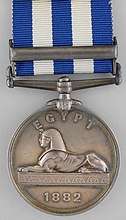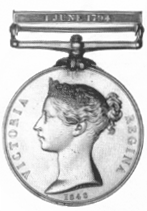
The Naval General Service Medal (NGSM) was a campaign medal approved in 1847, and issued to officers and men of the Royal Navy in 1849. The final date for submitting claims was 1 May 1851. Admiral Thomas Bladen Capel was one of the members of the board that authorised the medal.

The Military General Service Medal (MGSM) was a campaign medal approved in 1847 and issued to officers and men of the British Army in 1848.

The India General Service Medal was a campaign medal approved on 1 March 1854, for issue to officers and men of the British and Indian armies. It was awarded for various minor military campaigns in India and nearby countries, between 1852 and 1895.

The Indian General Service Medal was a campaign medal approved on 3 August 1938, for issue to officers and men of the British and Indian armies, and of the Royal Air Force.
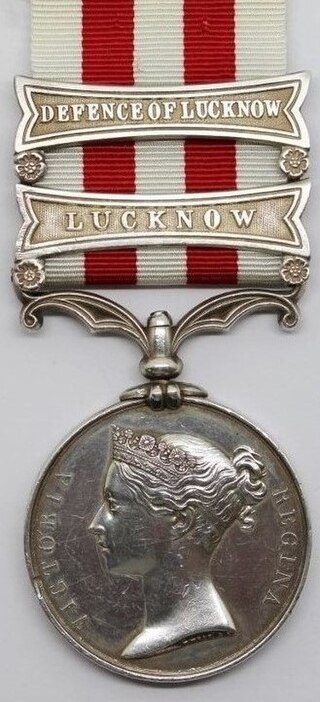
The Indian Mutiny Medal was a campaign medal approved in August 1858, for officers and men of British and Indian units who served in operations in suppression of the Indian Rebellion of 1857.

The Army of India Medal (AIM) was a campaign medal approved in 1851 for issue to officers and men of the British Army and the Army of the Honourable East India Company. A retrospective award following the precedent set by the Naval General Service Medal and the Military General Service Medal, it served to reward service in various actions from 1803 to 1826.
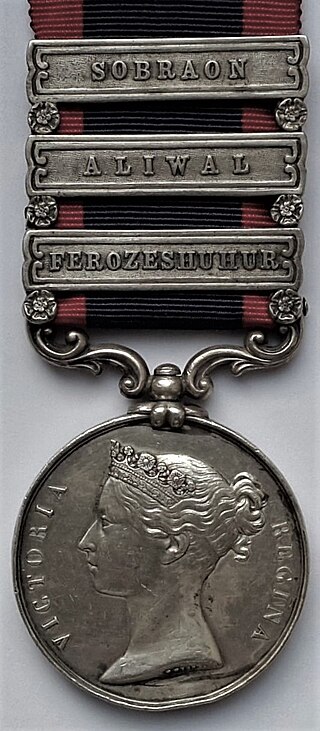
The Sutlej Medal was a campaign medal approved in 1846, for issue to officers and men of the British Army and Honourable East India Company who served in the Sutlej campaign of 1845–46. This medal was the first to use clasps to denote soldiers who fought in the major battles of the campaign.

The Battle of Toski (Tushkah) was part of the Mahdist War. It took place on August 3, 1889 in southern Egypt between the Anglo-Egyptian forces and the Mahdist forces of the Sudan.

The Battle of Ferkeh occurred during the Mahdist War in which an army of Mahdists was surprised and routed by Egyptian forces, led by Sir Herbert Kitchener, on 7 June 1896. It was the first significant action of the reconquest of Sudan, which culminated in the September 1898 Battle of Omdurman.

The Nile Expedition, sometimes called the Gordon Relief Expedition (1884–1885), was a British mission to relieve Major-General Charles George Gordon at Khartoum, Sudan. Gordon had been sent to Sudan to help the Egyptians withdraw their garrisons after the British decided to abandon Sudan in the face of a rebellion led by self-proclaimed Mahdi, Mahommed Ahmed. A contingent of Canadians was recruited to help the British navigate their small boats up the Nile River. The Nile Expedition was the first overseas expedition by Canadians in a British imperial conflict, although the Nile Voyageurs were civilian employees and did not wear uniforms.

The India Medal was a campaign medal approved in 1896 for issue to officers and men of the British and Indian armies.

The East and Central Africa Medal, established in February 1899, was a British campaign medal awarded for minor military operations in the Uganda Protectorate and Southern Sudan between 1897 and 1899. Four separate clasps were issued.

The Battle of Suakin, occurred on 20 December 1888 during the Mahdist War, when General Francis Grenfell defeated a Mahdist, force near Suakin, a chief port of Sudan.
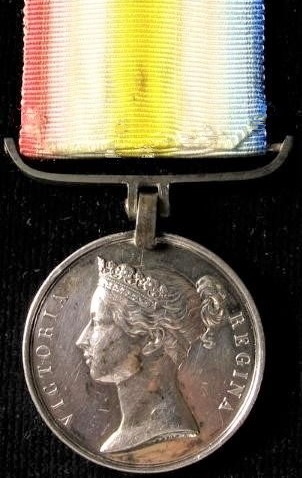
The Scinde Medal was authorised on 22 September 1843 and issued to soldiers of the Honourable East India Company, the 22nd Regiment of Foot of the British Army and members of the Indian Navy who crewed the Indus Flotilla, who participated in Major General Sir Charles Napier's conquest of Scinde between 1842 and 1843.

The Queen's Sudan Medal was authorised in March 1899 and awarded to British and Egyptian forces which took part in the Sudan campaign between June 1896 and September 1898.

The Ashanti Medal was sanctioned in October 1901 and was the first campaign medal authorised by Edward VII. This medal was created for those troops engaged in the Third Ashanti Expedition, also known as the War of the Golden Stool. This expedition lasted from March – December 1900, with the final outcome that the Ashanti maintained its de facto independence. Ashanti was made a Protectorate of the British Empire, but they ruled themselves with little reference to the colonial power.
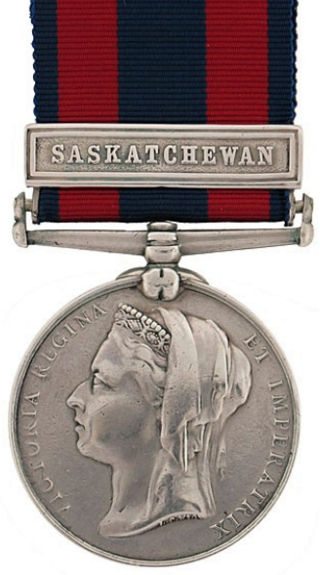
The North West Canada Medal is a British campaign medal issued to the soldiers, volunteers, and North-West Mounted Police (NWMP) personnel who participated in putting down the North-West Rebellion in 1885.

The Khedive's Star was a campaign medal established by Khedive Tewfik Pasha to reward those who had participated in the military campaigns in Egypt and the Sudan between 1882 and 1891. This included British forces who served during the 1882 Anglo-Egyptian War and the subsequent Mahdist War, who received both the British Egypt Medal and the Khedive's Star. Cast in bronze and lacquered, it is also known as the Khedive's Bronze Star.
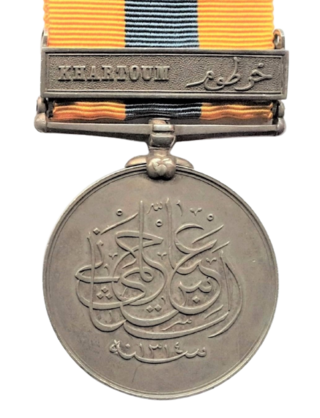
The Khedive's Sudan Medal was a campaign medal awarded by the Khedivate of Egypt to both Egyptian and British forces for service during the reconquest of the Sudan, the final part of the Mahdist War. Established 12 February 1897 by Khedive Abbas Hilmi Pasha, this medal was initially to commemorate the reconquest of the Dongola province in 1896. It was subsequently authorised for later campaigns and actions until 1908. The medal was awarded with fifteen different clasps.
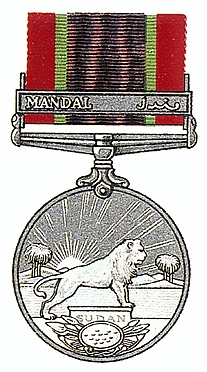
The Khedive's Sudan Medal was a campaign medal awarded by the Khedivate of Egypt for service in the Anglo-Egyptian Sudan. Established in 1911 by the Khedive, this medal replaced the earlier Khedive's Sudan Medal (1897) and was superseded by the Sudan Defence Force General Service Medal (1933).

